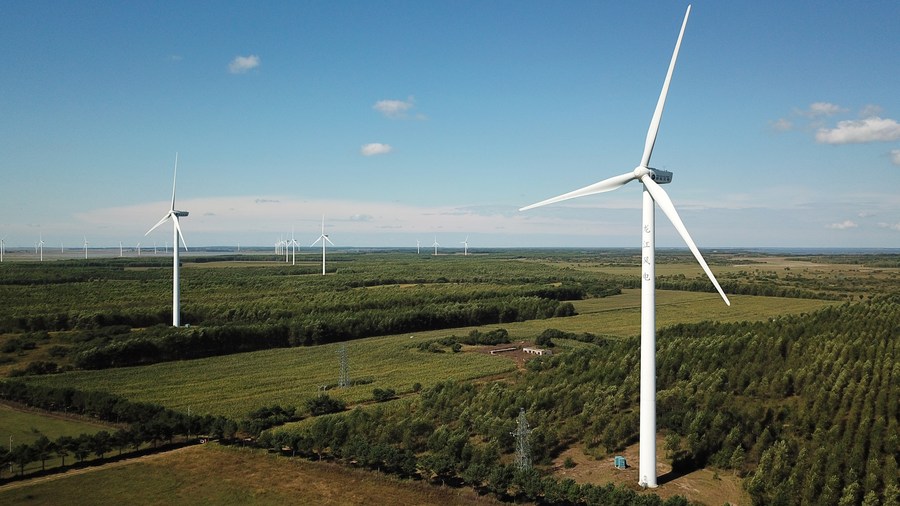LATEST INSIGHTS
Your Present Location: LATEST INSIGHTSDjoomart Otorbaev: Call for faster transition from fuel to materials-based energy systems
Source: CGTN Published: 2022-09-29
Editor's note: Djoomart Otorbaev is the former prime minister of the Kyrgyz Republic, a distinguished professor of the Belt and Road School of Beijing Normal University, and a member of the Nizami Ganjavi International Center. The article reflects the author's views and not necessarily those of CGTN.
In a previous publication on this topic, the article emphasized that today's world would witness a global transition from fuel-intensive to materials-intensive energy systems. And this transition must be conducted at an accelerated pace. Where are these materials located, and how to bring them to the markets?
Large-scale construction of new electrical networks will be a crucial area of need, especially for copper, accounting for 70 percent of today's demand. Wind power devices can play the most prominent role to drive up demand growth for these materials, especially given the growing contributions of offshore wind. Solar photovoltaic systems are not too far behind in consuming such materials. Meanwhile, hydropower, biomass and nuclear power will contribute only marginally to the growth in new materials consumption with a slight increase in their production capacity.
Neodymium is a rare earth element that, combined with iron and boron, plays an essential role in creating super-strong magnets used in wind turbine generators and batteries. Despite the name, a rare earth element such as neodymium is not particularly rare, and some of them are found in the same concentration in the earth's crust as copper.
The challenge is that an estimated 85 percent of the world's neodymium comes from a few mines in just one country – China. Other countries have several smaller mines, such as the Mountain Pass mine in California, the Mkango mine in Malawi, or the Rainbow Rare Earths mine in Burundi.
But even so, mines outside China tend to deliver the raw materials to China for processing, which is more profitable. It is predicted that as demand grows, other suppliers will enter the market, and there will be room for new mines to open. About 60 percent of the total extraction of rare earth elements is concentrated in China and 18 percent in the U.S. and 14 percent Myanmar.
Due to its quality and low resistance to the flow of electric current, copper remains indispensable in transmitting electrical energy. It is used in large quantities in virtually all clean energy applications, from batteries to solar panels to wind turbines. A feature of copper mining is finding areas where the metal is concentrated, preferably not too deep into the earth's surface.

A wind farm of the Daqing wind power project in Daqing, northeast China's Heilongjiang Province, September 8, 2021. /Xinhua
Once a copper deposit is discovered, the next step is to mine it, and new technologies are beginning to get applied in this area. Today, approximately 30 percent of the world's copper production is concentrated in Chile, and about 10 percent each in Peru and China.
Graphite is used to manufacture solar panels since it stands resistant to high temperatures and ideal for crucibles and moulds used for casting silicon in solar panels. It can also work as a heat shield and heat insulator. Without high-purity graphite, it would be impossible to create equipment for producing poly- and monocrystal silicon, and hence solar cells.
Besides, graphite is used to make anodes in automotive and autonomous batteries. Since the demand for various batteries is proliferating, an additional increase in graphite production will also be required. According to a World Bank report, just to meet the growing demand in these segments, graphite production will have to increase almost five fold by 2050. "About 4.5 million tons of graphite is needed to be produced annually by 2050, or a cumulative of 68 million tons, while graphite demand increases by nearly 500 percent from 2018 production figures, demonstrating the critical role graphite plays in the clean energy transition," the report says.
One of the main elements of clean energy is batteries, which will ensure an uninterrupted supply of electricity when the wind is not blowing and the sun is not shining. Lithium and cobalt are needed for their production. More than 85 percent of lithium production is concentrated in just three countries. Australia currently produces more than 50 percent, Chile about 22 percent, and China about 13 percent. Analysts suggest that the situation might soon change. With the growing popularity of renewable energy, new lithium mining projects will appear in the U.S., Canada, UK and Czech Republic.
With cobalt, things are not so optimistic. It is one of the most expensive materials in modern batteries. Until recently, 70 percent of the world's cobalt came from the mines in the Democratic Republic of the Congo. Researchers are putting much effort into creating cobalt-free batteries. Elon Musk even tweeted that he wants to eliminate cobalt from his batteries, but this looks unlikely.
Risks in the global energy transition include high uncertainties associated with growth scenarios for the demand for various vital minerals. There are both political and technological challenges. This ambiguity hinders the outlook for medium and long-term investments in mining and increases the likelihood that high mineral prices could delay this transition.
The global community must develop a coordinated climate plan and implement high social, environmental and governance standards. Trade and customs barriers and restrictions must be lowered or removed to allow markets to operate efficiently. Our planet must remain a comfortable place for living on it.
Key Words: percent,batteries,demand,Djoomart Otorbaev























































































 京公网安备 11010802037854号
京公网安备 11010802037854号





